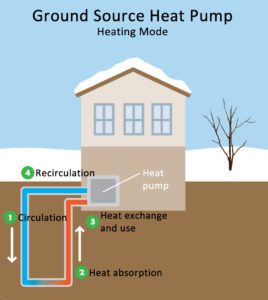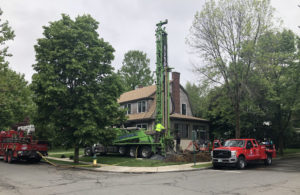By James Booth
One of the best options for home heating that doesn’t burn oil or natural gas is a heat pump. Heat pumps reduce the amount of energy you need to heat or cool indoor air. If you use fossil fuels to heat, a heat pump will let you use less fuel, which means fewer climate-changing greenhouse gases and less local and indoor air pollution.
Heat pumps work by using electricity to move heat between the inside and outside of a house, allowing efficient heating or cooling. There are two ways to do this: air-source heat pumps and ground source heat pumps (GSHPs).
Air-source heat pumps move heat between a building and the outside air. They are the focus of the current HeatSmart Belmont community campaign, described in the July/August 2019 Belmont Citizens Forum Newsletter.
GSHPs exchange heat with the ground through a fluid moving through underground pipes. GSHPs cost more to install than air source heat pumps due to the need to excavate and install pipes. However, Ground-source heat pumps are more efficient in that they use less electricity to deliver the same amount of heating (compared to electric resistance heating or air source heat pumps). The temperature 10 feet or more underground stays quite constant all year, about 55º Fahrenheit. This constant temperature makes it easier to extract heat in the winter, when the ground is warmer than the air above, and to cool air in the summer, when the ground is cooler than the air above. While air-source heat pump systems are 2-3 times more efficient than traditional electric baseboard heaters, GSHPs can be more than five times more efficient. Also, since the pipes of GSHPs are buried and thus protected from the elements, they are very long lasting, with lifetimes of many decades.
These GSHPs go by a variety of names, including ground-source heat pumps, geo-exchange, and geothermal. Confusingly, the word “geothermal” is also used to refer to direct use geothermal, an entirely different situation where the ground is very hot near the surface, such as the hot springs in Iceland or Yellowstone National Park. In our region, when people say “geothermal,” they are referring to heat exchange using the relatively constant temperature of the ground.
Several institutional buildings in Belmont have installed or will be installing ground-source heat pump systems, including the Beech Street Center and the Belmont 7-to-12 school that is currently under construction. Cambridge Savings Bank, as part of its longstanding support of green initiatives, installed a GSHP in its block-long building on Leonard Street.
Some homeowners in Belmont have also adopted ground-source heat pumps. Alan Savenor installed a GSHP at his property back in 2012, replacing an aging oil-based system with an environmentally friendly alternative.
Savenor’s GSHP system is a closed-loop system: an antifreeze solution circulates through underground pipes that descend 350 feet. (Deep pipes reduce the amount of land required compared to horizontal layouts.) As the antifreeze solution passes along those pipes, heat is exchanged with the earth around it.
The system is versatile. Savenor has three different heat exchangers inside the house to deliver warm air, radiant floor heating, and hot water. The system provides him with even heating that is delivered to multiple zones. He has seen large savings on his heating bills, and the system has required minimal maintenance over the years aside from occasional air filter replacements.
Belmont resident Katherine Oates is currently installing a GSHP for heating, cooling, and hot water. She considered switching from oil to gas heat, but she was motivated to consider ground-source heat pumps as the most efficient heating solution. The current federal tax credit for GSHPs, currently 30% through 2019, is dropping to 26% in 2020 and 22% in 2021, brought down the cost of the project. With the GSHP, she expects to also take advantage of Alternative Energy Credits available from the state, which are also available for solar and wind projects. In addition to its operating efficiency, the system will operate almost silently. Oates hopes to install solar panels in the future, which would help power the GSHP system with energy that is both low-cost and carbon-free.
As a highly efficient heating and cooling solution, ground source heat pumps are helping Belmont residents stay comfortable year-round while also greatly reducing emissions of the heat-trapping greenhouse gases that drive climate change. For more information about GSHPs and rebates, visit Massachusetts Clean Energy Center at bit.ly/2NoeCd2.
James Booth is a member of the Belmont Energy Committee, a co-author of its Climate Action Roadmap, and a HeatSmart Belmont coach.




Sorry, the comment form is closed at this time.